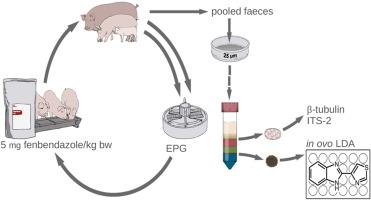通过粪卵计数减少试验、同型1 β-微管蛋白基因深度扩增子测序和卵幼虫发育试验揭示了德国户外饲养猪对猪线虫、食道口线虫和猪蛔虫的敏感性
IF 3.4
2区 医学
Q1 PARASITOLOGY
International Journal for Parasitology: Drugs and Drug Resistance
Pub Date : 2025-08-28
DOI:10.1016/j.ijpddr.2025.100612
引用次数: 0
摘要
猪食道stomum spp.和Ascaris suum是最常见的猪线虫,食道stomum对各种驱虫药的抗虫性(AR)已被报道。然而,目前德国农场蠕虫种群的AR状况和促进可靠AR检测的实用方法都缺乏。本文对13个有室外通道的养殖场使用苯并咪唑(芬苯达唑,5 mg/kg体重,单次给药)的效果进行了分析。粪卵计数减少试验(FECRT)对养殖场中圆形菌的估计(范围为99.8 - 100%)超过了新的W.A.A.V.P.食道齿状口指南的目标效率(99%)。本文首次对猪线虫进行了深度扩增子测序,结果显示1型β-微管蛋白基因的密码子134、167、198和200未发现与bz耐药相关的多态性。使用ITS-2深度扩增子测序的Nemabiome分析,基于两个治疗前和治疗后的样本,显示BZ治疗后四尖状食管口显著增加(p < 0.001)。对于A. suum,由于猪的食粪相关的假阳性卵子计数,对FECRT估计的解释可能会受到阻碍。因此,我们对A. susum进行了两次FECRT分析,第一次分析包括所有EPG数据,第二次分析认为EPG <;200治疗前和治疗后为阴性。采用卵内幼虫发育测定法(LDA)测定了猪棘球蚴对bz的体外敏感性。计算EC50范围为1.50 ~ 3.36 μM噻苯达唑(平均2.24 μM)。建议以3.90 μM噻苯达唑的EC50(平均EC50 + 3 × SD)作为耐药种群检测的临时截止值。结论:采用FECRT和β-微管蛋白深度扩增子测序,食道口未检测到AR。对于A. sum的FECRT结果是模糊的,在某些情况下,即使从计算中排除了低卵数。利用综合LDA,所有调查的猪种群均为BZ易感群体。本文章由计算机程序翻译,如有差异,请以英文原文为准。

Faecal egg count reduction test, deep amplicon sequencing of isotype-1 β-tubulin gene and in ovo larval development assay reveal susceptibility to benzimidazoles of porcine nematodes Oesophagostomum spp. and Ascaris suum in outdoor-reared pigs in Germany
Oesophagostomum spp. and Ascaris suum represent the most common porcine nematodes and anthelmintic resistance (AR) to various anthelmintics has been reported for Oesophagostomum. However, the current AR status for worm populations on German farms and practical methods facilitating reliable AR detection are missing. Herein, the efficacy of benzimidazoles (BZ) (fenbendazole, 5 mg/kg body weight, single dose) was analysed on 13 farms with outdoor access. The Faecal Egg Count Reduction Test (FECRT) estimates for strongyles on the farms (range 99.8–100 %) exceeded the target efficacy (99 %) of the new W.A.A.V.P. guideline for Oesophagostomum dentatum. Deep amplicon sequencing was used for the first time for porcine nematodes and revealed no polymorphisms associated with BZ-resistance in codons 134, 167, 198 and 200 of the isotype-1 β-tubulin gene. Nemabiome analysis using ITS-2 deep amplicon sequencing, based on two pre- and post-treatment samples, showed a significant increase (p < 0.001) of Oesophagostomum quadrispinulatum after BZ treatment. For A. suum, the interpretation of FECRT estimates can be hindered due to coprophagy-associated false-positive egg counts in pigs. Therefore, two FECRT analysis for A. suum were pursued, the first analyses included all EPG data, the second considered EPGs <200 pre- and post-treatment as negative. An in ovo larval development assay (LDA) was developed for the in vitro analysis of BZ-susceptibility in A. suum. Computed EC50 values ranged from 1.50 to 3.36 μM thiabendazole (mean 2.24 μM). An EC50 of 3.90 μM thiabendazole (mean EC50 + 3 × SD) as provisional cut-off for detection of resistant populations is suggested. In conclusion, no AR was detected in Oesophagostomum using the FECRT and β-tubulin deep amplicon sequencing. For A. suum the FECRT results were ambiguous, in some cases even when excluding the low egg counts from calculations. With the in ovo LDA all investigated A. suum populations were identified as susceptible to BZ.
求助全文
通过发布文献求助,成功后即可免费获取论文全文。
去求助
来源期刊

International Journal for Parasitology: Drugs and Drug Resistance
PARASITOLOGY-PHARMACOLOGY & PHARMACY
CiteScore
7.90
自引率
7.50%
发文量
31
审稿时长
48 days
期刊介绍:
The International Journal for Parasitology – Drugs and Drug Resistance is one of a series of specialist, open access journals launched by the International Journal for Parasitology. It publishes the results of original research in the area of anti-parasite drug identification, development and evaluation, and parasite drug resistance. The journal also covers research into natural products as anti-parasitic agents, and bioactive parasite products. Studies can be aimed at unicellular or multicellular parasites of human or veterinary importance.
 求助内容:
求助内容: 应助结果提醒方式:
应助结果提醒方式:


